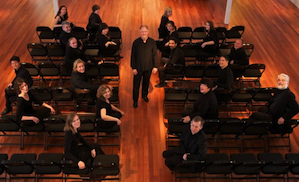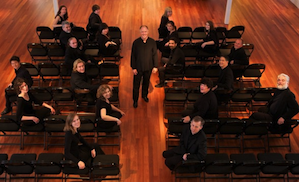
On Saturday, at All Saints’ Episcopal Church in Palo Alto, I attended an absolutely superb choral performance by Volti, directed by Robert Geary, on the theme of “War and Peace.” If you enjoy immaculate singing, well-planned programming, and passionate performance, then this is a group for you. In a word, this concert was masterful. Rather than simply run down the list of pieces and tell why each one was admirably executed, it's interesting to analyze a few of the components that I believe heightened my experience, beginning with the singing itself.
Frequently, when I attend choral performances, I brace myself for some questionable singing, whether from reedy sopranos, wide-vibratoed altos, or straining tenors. It’s incredibly rare to discover a group outside of a recording that measures up to my personal choral ideal. In Volti, there seem to be no weak links. Volti’s sopranos soared into the stratosphere of their range, and the piercing clarity of their sound was so effortless that I found myself immediately trusting them to carry the audience through the concert with ease. The altos and tenors supplied rich and steady middle voices, while the bass section provided a sense of solidness that was unwavering throughout the concert.
However, it’s not merely the quality of the voices that makes this choir excellent; to suggest so would be woefully ignorant of the nuances of choral singing, for I’ve heard many choirs filled with great singers whose voices, when combined, are strident and jarring. What makes Volti blend so well together is Geary’s treatment of both vibrato and vowel shapes. Though the choir was certainly not devoid of vibrato (and I think no choir should be), it was minimal and even. It enhanced the sound subtly, without overdoing it. For me, the most surprising and lovely vocal aspect of Saturday’s performance was the matched vowels. While this may seem a small thing, matching vowel shapes in a choir leads to excellent intonation and unparalleled blend. During only one moment did I hear two discordant vowels — an extraordinary level of uniformity.
In Volti, there seem to be no weak links. … What makes Volti blend so well together is Geary’s treatment of both vibrato and vowel shapes.
In addition to outstanding singing, Geary’s programming was also a highlight. While the theme of “War and Peace” is certainly not original, the pieces that he chose to explore this topic were thought-provoking, poignant, even tear-inducing. It’s rare that each work on a concert program easily renders physical chills. Moreover, the works matched each other in terms of timbre and also in the way the composers manipulated their chosen texts. Each composer reveled in shimmering chords that became almost luminescent in Volti’s capable hands. These complementary harmonies became an aural thread that wound itself through the program, binding the pieces tightly to one other.
One aspect I enjoy about new choral music is the varied and fascinating choice of text; I often use concerts as way of discovering new authors and poets. Saturday night was no exception. All the texts were thoughtfully chosen and expertly manipulated to highlight and comment on their contents. Repeating phrases and words often opened windows into the world of the composer, and by the end of the concert the audience understood what Forrest Pierce meant when he stated that as a composer of choral works, “you wake up and bathe in these words every day.”
In her work What do you think I fought for at Omaha Beach? Melissa Dunphy uses portions of testimony by 86-year-old Philip Spooner on the subject of equal marriage rights for same-sex couples. Composer David Smooke redacts large chunks of the Patriot Act to create a somewhat satirical and amusing commentary on that storied bill in his piece *A*R**T ACT, while in Ted Hearn’s work Ripple the composer manipulates a single cable from the Iraq War logs regarding the accidental killing of an Iraqi family. Though Shawn Couch and Forrest Pierce both set more-conventional poetry, their treatment of their texts is anything but traditional.
The pieces that he chose to explore [war and peace] were thought-provoking, poignant, even tear-inducing.
Couch’s work, Paradise, couples portions of poems by 12th-century Persian poet Hafez and Iraqi War veteran poet Brian Turner, creating a painfully beautiful and stark portrait of a war-ravaged region. Concluding the concert was Pierce’s take on Gary Snyder’s poem “Gratitude Sutra,” which provided a calming, cleansing ending after so much sorrow in the texts of the previous works.
While each piece was excellent — from Smooke’s artful use of quarter tones to Couch’s touching lullaby in Paradise —the highlight of the evening was the premiere of Pierce’s Gratitude Sutra. It’s a testament to Volti that, in accordance with the commissioning agreement, Pierce chose it as one of three choirs worldwide to premiere this work, the others being the BBC Singers and the Latvian Radio Choir. Having premiered a few of Pierce’s works with my college choir, I felt in Gratitude Sutra that I was slipping into a familiar sound world — triadic, frequently based in religious mysticism, and “blatantly tuneful.” Pierce subtly changes the harmonies and underpinning texture of each stanza in the work so as to highlight the beating of owl wings, the movement of water, the riotous reveling of “Wild Beings,” and the glorious warmth of the sun. Rather than obvious word-painting, however, Pierce’s technique is quiet, calm, and well-handled. This is not an explosion of color and detail, but rather the merest suggestion of a world — and it’s much more effective for its restraint.
Volti’s concerts should be packed to the rafters. They should no longer be a hidden gem.
It can be difficult to discern the various components of an emotionally moving experience: You know it’s happening, and yet there’s a certain mystique about how it transpires. The one aspect that detracted from Saturday evening’s performance was the size of the audience. Barely 50 strong in such a large space, it was shocking that such an outstanding professional choir could entice only a small number. Volti’s concerts should be packed to the rafters. They should no longer be a hidden gem. As patrons, we need to spread the word, mark our calendars, and plan on supporting this fabulous ensemble. Just in case you don’t have time to look it up, Volti’s next series of concerts takes place on May 16–18. I’ll see you there.

